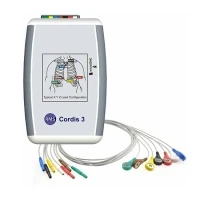
Allengers Holter Monitor
The Allengers Holter Monitor is a device used to constantly monitor a patient's heart activity over a fixed period, generally 24 to 48 hours, but sometimes up to a week. It's essential for diagnosing and managing various cardiac conditions by providing a comprehensive record of the heart’s electrical activity.
Key Features:
1. Continuous Monitoring:
- Long-Term ECG Recording: The Holter monitor records the electrical activity of the heart continuously for an extended period. This is crucial for detecting arrhythmias or irregularities that might not be apparent during a short, standard ECG test.
2. Compact Design:
- Portability: The monitor is typically small and lightweight, designed to be worn by the patient during their daily activities. It usually comes with a small recording device that can be clipped onto a belt or worn in a pocket.
3. Electrode Placement:
- ECG Electrodes: The device uses multiple electrodes attached to the patient's chest to record the heart's electrical signals. The number of electrodes and their placement can vary depending on the specific Holter monitor model.
4. Data Storage:
- Memory Capacity: The monitor has sufficient storage to record and store data for the entire monitoring period. This data can be later transferred to a computer for analysis.
5. Data Analysis:
- Software Integration: The recorded data is analysed using specialized software that can detect and document abnormal heart rhythms, ST-segment changes, and other significant cardiac events. The software typically provides detailed reports and visualizations for the healthcare provider.
6. User Interface:
- Display and Controls: Some Holter monitors have a simple interface for basic controls and status indicators, while others may connect to a computer or other devices for programming and data retrieval.
7. Patient Comfort:
- Wearability: Designed to be as unobtrusive as possible, allowing patients to continue with their daily activities while wearing the monitor. Comfort features include lightweight materials and secure but gentle electrode adhesives.
Applications:
1. Arrhythmia Detection:
- Diagnosis: Helps in diagnosing arrhythmias that may not be detected during a standard ECG due to their intermittent nature.
2. Symptom Correlation:
- Symptoms Tracking: Useful for correlating symptoms such as palpitations, dizziness, or syncope with heart activity.
3. Post-Surgical Monitoring:
- Recovery Assessment: Monitors heart function after procedures like catheter ablation or heart surgery to ensure normal rhythm and function.
4. Treatment Evaluation:
- Therapy Effectiveness: Assesses the effectiveness of treatments for cardiac conditions by monitoring changes in heart rhythms over time.
Advantages:
1. Extended Monitoring: Provides a comprehensive view of heart activity over an extended period, which can capture transient or sporadic arrhythmias.
2. Patient Activity: Allows patients to go about their normal activities, providing a real-world assessment of heart function.
3. Detailed Analysis: Offers a detailed and accurate analysis of heart rhythms, helping in precise diagnosis and treatment planning.
